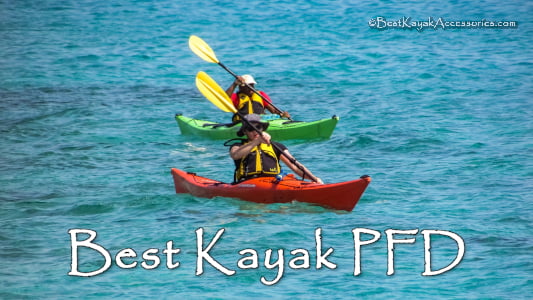Along with your kayak and your paddle, your PFD (personal flotation device) is one of the most critical pieces of equipment for your kayak trips. Your PFD will assist you if you ever capsize or fall out of your kayak. The best PFD for kayaking will fit property, but will not restrict your movement. You want to be able to paddle with full range of motion while wearing your PFD.

1. NRS Chinook Fishing PFD Shop Now
- Type III – 16.5 lbs buoyancy rating
- 200 denier ripstop nylon w/ mesh lower back
- 8 adjustment points
- 7 various sized pockets
- 4 color options
2. Kokatat OutFIT Tour PFD Shop Now
- Type III – 16.5 lbs buoyancy rating
- 500 denier Cordura shell, 200 denier nylon interior
- 5 adjustment points
- 4 pockets
- 3 color options
3. Stohlquist Edge Life Jacket Shop Now
- Type III – 15.5 lbs buoyancy rating
- Ripstop nylon shell
- Adjustable shoulders, 4 side pulls, and waist buckle
- Large top-load front pocket
- 4 color options
4. Astral Ronny Life Jacket PFD Shop Now
- Type III – 16 lbs buoyancy rating
- 200 denier nylow shell
- Multiple pockets
- 8 color options
5. Onyx MoveVent Dynamic Paddle Sports Life Vest Shop Now
- Type III
- 200 denier ripstop nylon
- Shoulder and side adjustment straps
- Zippered pocket
- 3 color options
- See: Onyx MoveVent Dynamic Review
6. NRS Ninja PFD Life Jacket Shop Now
- Type III – 16.5 lbs buoyancy rating
- 200 denier ripstop nylon
- 6 adjustment points
- Large top-load front pocket
- 4 color options
7. MTI Adventurewear Helios 2.0 Inflatable PFD Life Jacket Shop Now
- Type III – 26.13 lbs buoyancy rating
- Uses 24g CO2 cartridge for inflation
- Neoprene padded yoke
- Zippered front pocket
8. NRS Clearwater PFD Shop Now
- Type III – 16.5 lbs buoyancy rating
- 400 denier ripstop nylon
- 6 adjustment points
- 2 large pockets
- 2 color options
Shop for the Best PFD for kayaking now: Shop Now
Choosing the Best PFD for Kayaking
PFD Sizing:
Adult PFDs are sized by your chest size, not your weight. The best PFD for kayaking should fit snug, but still comfortable and allow full movement. Tighten straps from the bottom of the vest to the top, with the shoulders being last. Check the sizing by someone pulling up on the shoulders. If it moves up, you may need to tighten the straps or get a smaller size.
PFD: Vest or Inflatable?
Vest
Pros
Low maintenance
Naturally buoyant
Can be used for multiple purposes/activities
Cons
Bulky
Can be hot
Inflatable
Pros
Comfortable
Cooler temperature-wise
Cons
Inflation required to work
Maintenance to ensure proper operation
Must buy replacement cartridges
PFD Specs:
Buoyancy: This is the amount of force needed to keep a person’s head and chin above water. Usually 7-12 pounds is the most that is needed, but this amount varies based on a lot of conditions. Most PFDs offer higher buoyancy than needed in most normal conditions.
USGC Classifications: Most PFDs for kayaking are type III. These are more comfortable than Type I or II, but won’t turn the wearer face-up. These are good for protected, inland water where the chance of immediate rescue is good. Not designed for extended survival in rough water. See Boat US for more info on other PFD types.







